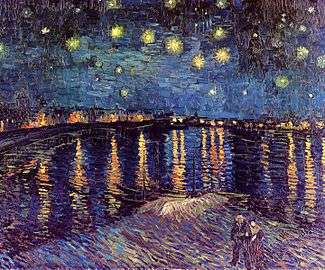Starry Night Over the Rhone
 | |
| Artist | Vincent van Gogh |
|---|---|
| Year | 1888 |
| Catalogue | F474; JH1592 |
| Medium | Oil on canvas |
| Dimensions | 72.5 cm × 92 cm (28.5 in × 36.2 in) |
| Location | Musée d'Orsay, Paris |
Starry Night Over the Rhone (September 1888) is one of Vincent van Gogh's paintings of Arles at nighttime. It was painted at a spot on the bank of the Rhone River that was only a one or two-minute walk from the Yellow House on the Place Lamartine which Van Gogh was renting at the time. The night sky and the effects of light at night provided the subject for some of his more famous paintings, including Cafe Terrace at Night (painted earlier the same month) and the later canvas from Saint-Rémy, The Starry Night.
A sketch of the painting is included in a letter van Gogh sent to his friend Eugène Boch on October 2, 1888.[1]
The painting was first exhibited in 1889 at the annual exhibition of the Société des Artistes Indépendants in Paris, together with the Irises. The latter was added by Theo, while Vincent had proposed one of his paintings from the public gardens in Arles, most probably the version now in the Phillips Collection.
Subject matter

The view is from the quay (a waterside street) on the east side of the Rhone, into the knee of the river towards the western shore: coming down from the north, the Rhone turns to the right at this point to surround the rocks on which Arles is built. From the towers of Saint-Julien and Saint-Trophime at the left, the spectator follows the east bank up to the iron bridge connecting Arles to the suburb of Trinquetaille on the right, western bank. This implies a view from Place Lamartine towards the south-west. 43°40′57″N 4°37′49″E / 43.682367°N 4.630287°E
Genesis
Van Gogh announced and described this composition in a letter to his brother Theo:
Included a small sketch of a 30 square canvas - in short the starry sky painted by night, actually under a gas jet. The sky is aquamarine, the water is royal blue, the ground is mauve. The town is blue and purple. The gas is yellow and the reflections are russet gold descending down to green-bronze. On the aquamarine field of the sky the Great Bear is a sparkling green and pink, whose discreet paleness contrasts with the brutal gold of the gas. Two colorful figurines of lovers in the foreground.[2]
In reality the view depicted in the painting faces away from Ursa Major, which is to the north. The foreground indicates heavy rework, wet-in-wet, as soon as the first state was finished.[3] The letter sketches executed at this time probably are based on the original composition.
Colors of the night
The challenge of painting at night intrigued van Gogh. The vantage point he chose for Starry Night Over the Rhone allowed him to capture the reflections of the gas lighting in Arles across the glimmering blue water of the Rhône. In the foreground, two lovers stroll by the banks of the river.
Depicting color was of great importance to Vincent; in letters to his brother, Theo, he often described objects in his paintings in terms of color. His night paintings, including Starry Night Over the Rhone, emphasize the importance he placed on capturing the sparkling colors of the night sky and of the artificial lighting that was new to the era.
In popular culture
The painting is referenced in Brian Eno and John Cale's song "Spinning Away" from the 1990 album Wrong Way Up. In the second verse the singer's view is described as "like the night sky at Arles".
Notes
- ↑ Letter to Eugène Boch including a sketch of the Starry Night over the Rhone painting
- ↑ Letter 543
- ↑ For a tracing of the original composition see Roland Dorn 1990, ill. p. 388
References
- Boime, Albert: Vincent van Gogh: Starry Night. A history of matter, a matter of history (also available on CD-ROM: ISBN 3-634-23015-0 (German version))
- Dorn, Roland: Décoration: Vincent van Gogh's Werkreihe für das Gelbe Haus in Arles, Georg Olms Verlag, Hildesheim, Zürich & New York 1990 ISBN 3-487-09098-8 / ISSN 0175-9558
External links
-
 Media related to Starry Night Over the Rhone at Wikimedia Commons
Media related to Starry Night Over the Rhone at Wikimedia Commons